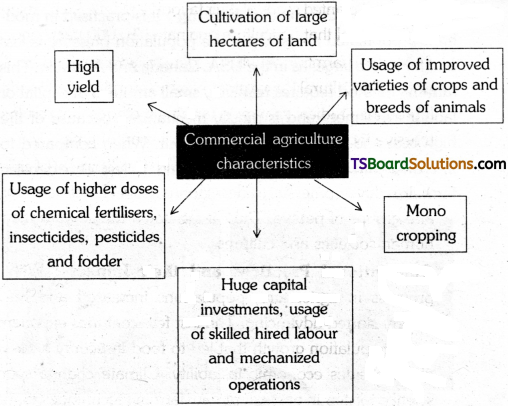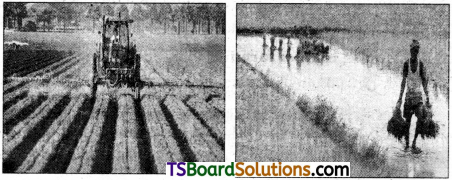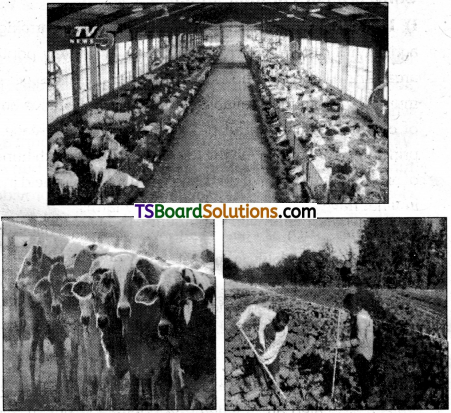Telangana TSBIE TS Inter 1st Year Environmental Education Study Material 22nd Lesson Conventional Practices of Agriculture Textbook Questions and Answers.
TS Inter 1st Year Environmental Education Study Material 22nd Lesson Conventional Practices of Agriculture
Essay Questions
Question 1.
Write an essay on conventional practices of agriculture.
Answer:
Agriculture, which has been the backbone of human existence, can be defined as the cultivation and exploitation of animals and plants for human use. It includes food, fiber, medicines, fuel etc., and preservation of erops.
Early hymariS’were nomadic and depended on hunting and gathering to supply their food. Cultivation of plants may have arisen accidentally but farming began when people intentionally saved and planted seeds of their favourite plants. Archaeological studies reveal that agriculture originated 10,000 years ago.
Modern farming or what is generally referred to as “The British Agricultural Revolution” began around the 18th century. It brought a radical change in farming methods that resulted in massive increases in yields in a short span of time.
Agriculture played a vital role in the establishment of cities as well as development of trade relations between different regions and groups of people. Thus, it facilitated the advancement of human societies and cultures.
Conventional Practices and their Impact :
With the progress in agriculture, populations increased and human society started advancing. The last few centuries experienced rapid population growth that led to food insecurity across the globe besides economic instability. Climate change spurred science to step in and adopt new farming techniques to maximize the potential of plants to feed the ever increasing population, Conventional Farming and Green Revolution are the resulting initiatives. They produced an unprecedented growth in agriculture worlwide over the last century.
![]()
Conventional farming, also known as Industrial agriculture or Mainstream farming, refers to farming systems which include the use of synthetic chemical fertilizers, pesticides, herbicides and other continual inputs, heavy usage of farm machinery, selective breeding, genetically modified organisms, heavy irrigation, intensive tillage, or concentrated animal feeding operations and concentrated monoculture production. Thus it results in high inputs of capital, labour, heavy machinery and technology. The goal of conventional agriculture is to maximize the potential yield of crops.
Characteristics of Conventional Agriculture :

Conventional Fanning Methods :
I) Intensive Commercial Farming :
Intensive fanning is an agricultural system, which is carried on in densely populated areas and where land holdings are small. It aims to get maximum yield from the available land by using excessive amount of chemical fertilizers and pesticides on a tiny acreage. This principle is also applied to the raising of livestock with hundreds of animals, such as cows, pigs and chickens, being held indoors in what have become known as factory farms.
Products, such as eggs, meat, and other agricultural items that are easily available in markets today are produced through intensive farming methods. This is a system of agricultural which requires relatively large amounts of capital and labour. IntenaiveTarming is practised in countries like India, China and the UK.
II) Extensive commercial farming :
It is practised in moderately populated areas where the population pressure is less and farms are large, as in the USA, Canada and Australia. This farming method requires relatively small amounts of capital or labour investment and is mostly mechanized because of the high cost and low availability of labour. When compared to intensive farming, the per capita yield is less in extensive farming.


III) Plantation agriculture :
Plantation is an estate or a large piece of land. Plantation agriculture involves growing and processing of a single cash crop purely meant for sale in distant markets rather than local consumption. Examples of this type of farming are the tea plantations in Assam and West Bengal, the coffee plantations in Karnataka and Tamil Nadu, rubber plantations in Kerala, grapevine plantation in Italy and France and olive plantations in Mediterranean countries.
IV) Co-operative fanning :
Co-operative farming is a relatively new farming method in India where pooling of land and farming resources such as fertilisers, pesticides, farming equipment such as tractors takes place. Profit on total produce is shared by the farmers in accordance with their land contribution and labour performed.
V) Shifting agriculture :
Shifting cultivation is a form of agriculture, used especially in tropical Asia in which an area of land is cleared of vegetation and cultivated for a few years, then abandoned and allowed to revert to its natural fertility. Meanwhile the cultivator moves on to another area.
VI) Slash and bum agriculture :
In Slash-and-bum agriculture, or fire-fallow cultivation, areas of the forest are burned and cleared for planting. The resulting layer of ash provides the newly-cleared land with a nutrient-rich layer to help forillze crops.
VII) Poultry farming :
Poultry farmirig is the process of raising domesticated bills such as chickens, ducks, turkeys and geese for the purpose of farming meat or eggs for food.
VIII) Dairy farming :
Dairy farming is a class of agriculture for the long-term production of milk from cows or goats, or buffaloes or camels, which is processed for eventual sale of a dairy product.
IX) Sericulture or silk fanning :
Sericulture or silk farming is the cultivation of silkworms to produce silk.
Benefits of Conventional Farming :
In the modern world, conventional farming is considered a necessity for the following reasons.
- Manifold increase in the yield.
- Easy to meet the nutritional demand of the growing population.
- Affordable sale price of products.
- Less chance of the crop being lost to environmental factors like drought, floods, plant diseases.
- Offers plenty of job opportunities.
![]()
Question 2.
Describe the impact of conventional agricultural practices.
Answer:
Though conventional farming has delivered tremendous gains in productivity and economy and contributes to global food security, it has brought its share of environmental, socioeconomic, health and other concerns too.
| Health Concerns | Excessive use of fertilizers, pesticides, and heavy metals have an adverse impact on human, plant, and aquatic life. |
| Chemical pesticides have been linked to cancer, allergies, birth defects, Alzheimer’s and many other disorders. | |
| As their risk of -vnosure to pesticides and other toxins is very high, the health of farm workers is also of concern. | |
| Pesticides and heavy metals enter the tooa chain causing Bioaccumulation and move from one trophic level to the next causing Biomagnification. | |
| To protect livestock from diseases, antibiotics are widely used in meat and dairy production. This leads to antibiotic resistance in humans. | |
| Environmental concern | Loss of soil organic matter, reduction of water holding capacity and depletion of soil fertility due to excessive use of synthetic fertilisers, pesticides and herbicides. Biological activity is restricted. This may threaten the future sustainability of crop production on a global scale. |
| These chemicals are found to contribute to non-profit source water pollutants. Nutrient runoff reduces the water quality of surface water bodies. convening them into eutrophicated and dead zones. | |
| Salinization of soils at highly-irrigated farming areas due to excessive run-off and nutrient loss. Globally 5 to 7 million hectares of farmland are degraded each year in this manner. | |
| Several insects, mite pests and fungal pathogens have become resistant to many pesticides and their control requires usage of progressive generation of high concentrated pesticides. | |
| Environmental concern | Reduced water quality impacts drinking water supplies and agricultural and nshery poroduction |
| Killing unwanted pests along with natural predators of those pests occurs due to usage of pesticides. Pesticides also put stress on pollinators and other beneficial insect species. | |
| Contamination of ground water beneath agricultural areas due to chemical leaching. | |
| Overuse of surface and ground water for irrigation, with little concern leads to water scarcity and affects the stable water availability by disrupting the natural water cycle. | |
| Desertification can be-caused by overgrazing of livestock and is a growing problem, especially in parts of Africa. | |
| Deforestation in the name of agriculture has led to loss of biodiversity and elevated levels of carbondioxide and other greenhouse gases in the atmosphere. | |
| Deforestation and use of fossil fuels to run farm equipment results in the direct negative effect on environment through release of CO2 and other greenhouse gases. | |
| Crop diversity is threatened due to the introduction of Genetically modified crops as genes of GMOs can spread to non GMO plants and can result in genetic drift, thereby having devastating effects on traditional varieties. | |
| Socio-economic concern | It is very expensive as most operations are mechanized. |
| Farmers have little control over prices of their goods, and they continue to receive very less profit as the market competition is limited. | |
| It is very difficult for small farmers to enter the business because of the high cost of doing business. During the past few decades farmers, particularly those having small farms, have incurred heavy losses. | |
| The produce obtained in terms of quantity is high but quality is compromised. | |
| Cultivation of mono-crops for several years may encourage increase of pests and outbreak of disease which will have devastating effects. |